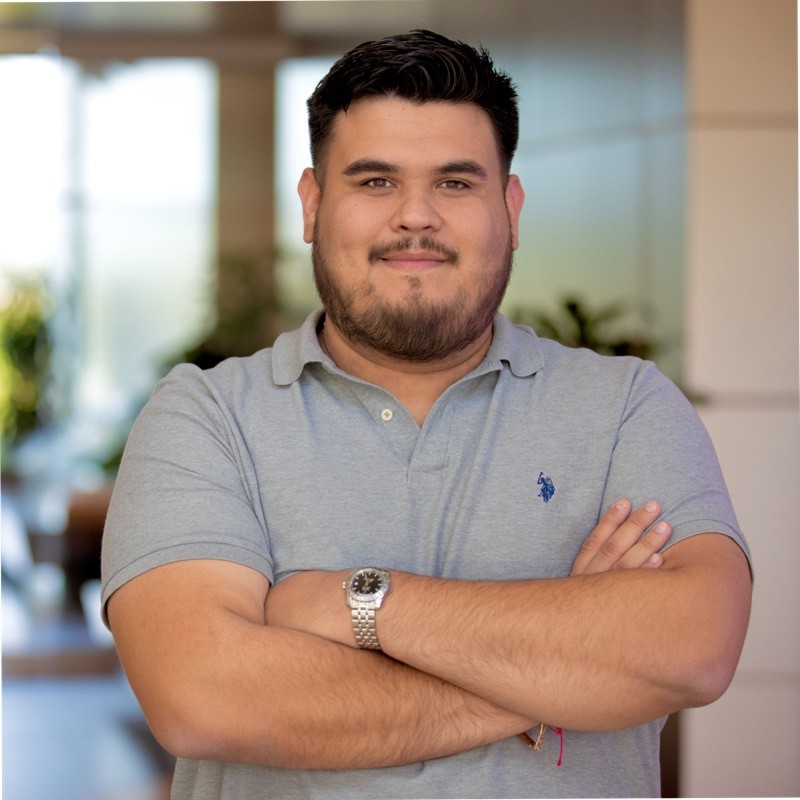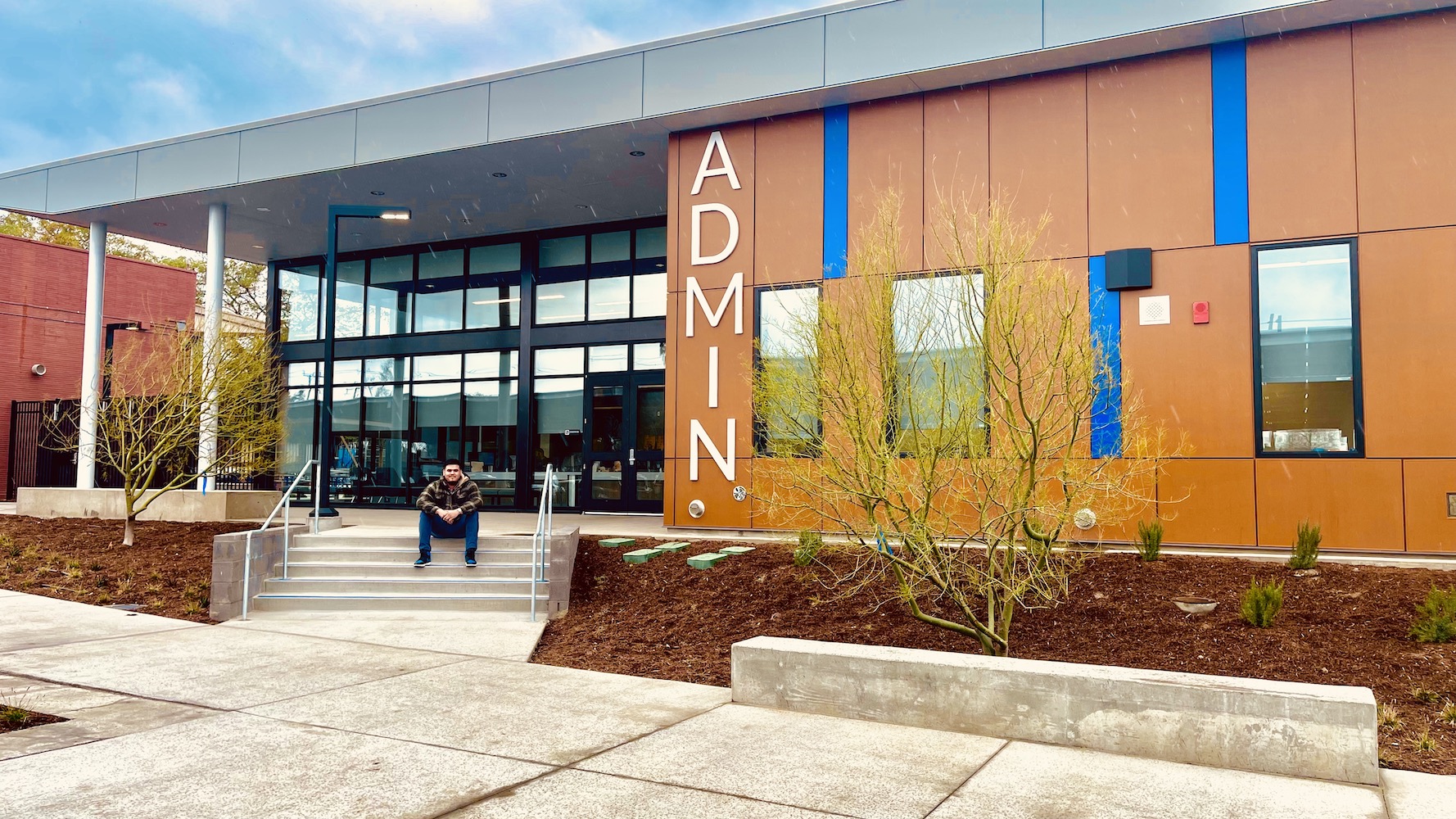
“My final internship with Ruhnau Clarke Architects, a well-known firm in the Inland Empire with strong ties to CBU, transitioned into a full-time role for five years. It truly shaped my professional career and helped launch me forward at an early stage.”
Quick Facts
Program: Master of Architecture, MArch
Graduation Year: 2020
Current Job Title: Architectural Senior Designer at PBK Architects
Hometown: Puerto Vallarta, Mexico
Current City: Rialto, CA

Life at CBU
Why did you choose your program? What interested you in this particular field of study?
Since I was a kid, I’ve always been interested in art and creating things. I even
spent a few years taking lessons from a local artist in my hometown, thinking I would
follow a purely artistic path. But one day, while visiting my neighbor’s house, I
saw one of the older brothers working on an architectural model. Watching how his
vision took shape — how an idea could become something physical and tangible — completely
shifted my perspective. From that moment, I knew I wanted to pursue architecture.
It felt like the perfect blend of art and creation, where imagination meets practical
design to shape real spaces and experiences. That mixture of creativity and making
things real has inspired me ever since.
What did you like about being in this program at CBU?
What I appreciated most about being in the program at CBU was the balance between
creative exploration and practical, real-world application. The professors encouraged
us to think conceptually but also grounded us in the technical skills essential for
professional practice. I enjoyed the collaborative environment — working alongside
classmates with different perspectives really helped me grow as both a designer and
a problem-solver.
I also believe that because the program was still in its early stages, and many of
the professors were relatively young professionals, they played a key role in shaping
and improving the program. They brought in fresh, real-world insights and adapted
the curriculum as they saw opportunities, often pulling in elements from other programs
to make CBU’s approach even stronger. That flexibility and willingness to evolve the
program made the learning experience much more dynamic and relevant.
Overall, CBU provided an environment where creativity was valued, but so was the discipline
needed to turn ideas into real, buildable solutions.
What did you think about your professors?
The program at CBU was enjoyable and successful largely because the professors were
approachable and genuinely invested in our growth. I appreciated their constant flexibility
and willingness to mentor us, often going above and beyond to help us understand not
just the “how” but the “why” behind design decisions. They demanded quality work,
but they paired that with patience and support, creating an environment where we felt
challenged yet encouraged.
What stood out most was how they ingrained in us the importance of asking questions
— understanding the user, identifying real needs and always approaching design with
empathy. Their focus wasn’t just on creating architects, but on shaping leaders who
design spaces that truly serve and benefit others. That mindset has stayed with me
and continues to shape how I approach my work today.
Did you complete an internship?
Yes, I completed multiple internships during my time at CBU. In my sophomore year,
I interned at a small firm in Claremont called Wheeler & Wheeler. It was a great first
experience where I learned how a small firm operates, and I gained a better understanding
of the day-to-day processes behind running projects.
My second internship was at TR Designs, a local firm in Riverside. That experience
allowed me to dive deeper into the role of a designer. I wasn’t limited to just one
task — I was exposed to multiple aspects of architectural work, which helped me see
the broader dimensions of the profession and develop my design skills more holistically.
My final internship, which transitioned into a full-time role for five years, was
with Ruhnau Clarke Architects — a well-known firm in the Inland Empire with strong
ties to CBU. At Ruhnau Clarke, I was given opportunities that truly shaped my professional
career and helped launch me forward at an early stage. I had the chance to design
several buildings and also refine my technical skills, gaining experience in both
creative design and detailed project execution.
Each of these internships contributed in a different way to my growth as a designer
and professional.
Did you participate in anything else at CBU?
I was part of the National Organization of Minority Architecture Students for two
years — first as a member and later as president of our CBU chapter. Being involved
with NOMAS opened up many valuable opportunities, including collaborating and networking
with students from other architectural programs across the region. Through the organization,
I met great people who shared the same passion for design and community, and I also
had the chance to participate in two architectural competitions, which helped push
my creative thinking and teamwork skills.
How did you grow while in this program at CBU?
During my time in the architecture program at CBU, I experienced significant growth
on many levels. Educationally, the program pushed me to think critically and creatively.
I didn’t just learn how to design buildings — I learned how to problem solve, think
empathetically and approach design as a tool to serve people.
Socially, the program encouraged collaboration and community. Working closely with
classmates on projects and in organizations like NOMAS helped me build strong relationships
and learn the value of different perspectives in the design process.
Spiritually, being at a faith-based university like CBU reminded me of the importance
of purpose in my work. I learned to see architecture as more than just a career —
it’s a way to impact lives and serve communities. That mindset shaped how I approach
design, keeping people and their needs first.
Did your program help you figure out your purpose?
Yes, my program at CBU definitely helped me clarify my purpose. Through both the classes
and the mentorship from professors, I came to see architecture not just as a profession
but as a way to serve others. The focus on designing with empathy, understanding the
user’s needs and approaching each project with purpose really shifted how I saw my
role as a designer.
Life after CBU
What have you done since graduating?
Life after CBU has definitely been rewarding. I’ve had the opportunity to achieve
several career milestones, including designing an award-winning project and contributing
to significant, career-defining works. Recently, I made the move to a large firm with
a strong vision for the future — an environment where I can continue to grow, surrounded
by talented mentors and professionals who inspire me to improve every day.
Although my career is still young, it has already been very fruitful, largely due
to the discipline and commitment I bring to my work. But most importantly, it’s the
key people around me who motivate and support me that have made all the difference,
along with my faith. Thanks to God, I now have a family of my own. My child and soon-to-be
fiancée are blessings that I deeply cherish, and they inspire me to keep striving
for the best in both my personal and professional life.
How has your program and time at CBU prepared you for your life and career after college?
My program and time at CBU prepared me exceptionally well for both my life and career
after college. Academically, the program gave me a solid foundation in architectural
design, technical skills and critical thinking. More importantly, it taught me how
to approach projects with empathy and a user-centered mindset, which has been invaluable
in real-world practice.
Beyond the classroom, CBU’s supportive community and close-knit environment helped
me build lasting relationships and develop teamwork and leadership skills.
Overall, CBU prepared me not just as an architect, but as a thoughtful leader and
person ready to make an impact in my profession and life.
Is there anything you learned at CBU that you still use in your professional life
today?
Without a doubt, the most important lesson I learned is to design with empathy rather
than ego. This was something I didn’t fully appreciate until I entered the professional
world and saw firsthand how empathy leads to better, more thoughtful projects. Designing
with the user’s needs and experiences at the forefront — not personal preferences
— truly makes a meaningful difference in the quality and impact of the work.
How are you making a difference in the world? How are you living your purpose?
I believe I’m making a difference in the world by designing spaces that prioritize
the needs and well-being of the people who use them. Through my work, I strive to
create environments that are not only functional but also welcoming and inspiring,
helping to improve quality of life and foster community.
Living my purpose means approaching every project with empathy and intentionality.
What are your future goals and plans?
My future goals are to continue growing as a professional and to become a well-rounded
leader in my field. I aspire to support and mentor others in reaching their own goals,
just as I have been guided and encouraged by mentors throughout my journey. Helping
others succeed and fostering a collaborative environment is as important to me as
advancing my own career.
Would you recommend CBU to others?
I would definitely recommend CBU to others. After I graduated, my brother became interested
in attending CBU, and he recently completed his master’s degree there. Now, my youngest
sibling is also considering attending CBU in the near future. Having multiple family
members choose CBU speaks to the quality of education and supportive community the
university provides.

